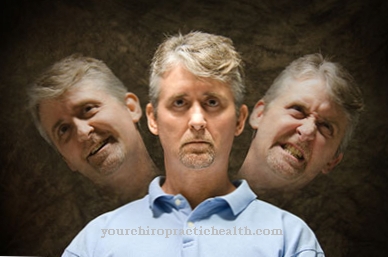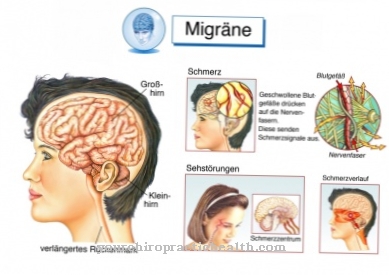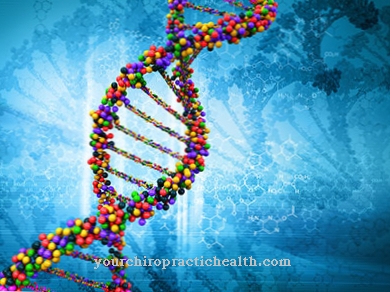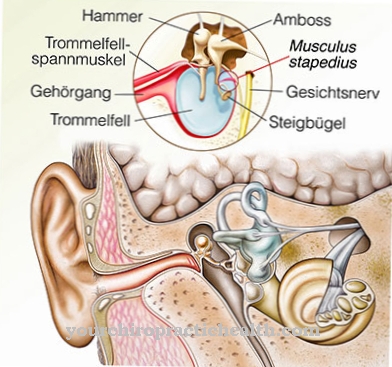The De Grouchy Syndrome is a malformation complex of which various subspecies exist. The multiple malformations are caused by deletions on chromosome 18. The patients are treated symptomatically only.
What is De Grouchy Syndrome?

© imagenavi - stock.adobe.com
The so-called malformation syndromes are a group of diseases that manifest themselves in a complex of various malformations. A subgroup of this group of diseases is the so-called De Grouchy syndrome, which is divided into two different types with different symptoms. De Grouchy syndrome was first described from a scientific perspective in 1963.
A little more than 100 cases have been documented since the first case description. The first type of the syndrome is considered to be severe and is associated with numerous symptoms, especially reduced muscle tension, malformations of the hands, autoimmune symptoms and heart defects. Type II of the syndrome is slightly more pronounced and is not associated with organic malformations, for example. Instead, this type has lead symptomatic short stature.
The two syndromes are sometimes summarized as deletion syndromes of chromosome 18, since they are due to deleting mutations of this chromosome. A mixture of the two sub-forms is known as the 18-R syndrome. The severity of the syndromes can vary greatly and depends on the length of the chromosmal deletion in each individual case.
causes
The cause of all forms of De Grouchy syndrome is a genetic mutation that is associated with familial accumulation. Chromosome 18 is affected by deletions in all diseases of the group. Parts of the chromosome have been deleted, which explains the individual symptoms of the syndromes. Thus, all forms of the syndrome are based on partial monosomies.
With this type of numerical chromosome aberration, individual chromosomes are missing.In the case of De Grouchy syndrome, the monosomies relate to chromosome segments in gene location 18q23. Chromosome 18, for example, contains genes that code for the glycoprotein APCDD1 in DNA.
In addition, it contains genes that code for the metabolic regulator Bcl-2 of the mitochondria in ischemic conditions. In addition, certain genes of the chromosome code for the basic myelin protein MBP, which is particularly important for the myelin sheath of nerve cells and explains the characteristic muscle weakness of those affected by the syndrome.
Type I of De Grouchy syndrome has a piece loss on the short arm of chromosome 18. Type II of the syndrome is based on a piece loss on the long arm 18q22-23 of the chromosome. If the ring chromosome has 18 deletions on the long and short arm, a combination of the typical features of De Grouchy patients of type I and II is established.
You can find your medication here
➔ Medicines for painSymptoms, ailments & signs
Patients with De Grouchy syndrome type I have a low birth weight and show somatic hypotrophy with decreased muscle tension. Often their hands are large and have short fingers, which are sometimes associated with four-finger furrows, lateral curved phalanges and toe syndactylies. In addition, there is often a heart defect and an abnormal bowel position.
Other symptoms can include big ears. In addition, type I often manifests as atresia or stenosis of the ear canals. A funnel chest and brain or head abnormalities such as short-headedness also occur. In addition to brachycephaly and holoprosencephaly, there may be one-eyedness or a non-positioning of the olfactory brain. The cranial sutures of those affected often close prematurely and cause a cognitive disability.
Malformations of the eye muscles, ocular dysmorphism and malformations of the eye sockets are just as characteristic of type I as orbital dysmorphism and small or widely spaced eyes. In addition to hypertelorism, narrow eyelids, blepharophimosis and drooping of the eyelids can speak for type I. Ptosis, glaucoma or a squint with trembling eyes are also characteristic.
Patients' lower jaws are often underdeveloped or recessed, the mouth gap is wide, and the teeth develop abnormally. The nasal cavities are often connected to the throat and patients suffer from retarded bone age, which leads to growth retardation. The spine often bends and creates a hump.
In addition, there is often inflammation of the thyroid gland, which can also lead to an immune deficiency with autoimmunological symptoms and a deficiency in immunoglobulin A. Patients often suffer from type 1 diabetes mellitus in their youth. Girls often do not menstruate. The main symptom of type II of De Grouchy syndrome is a pituitary-related short stature.
This symptom is associated with microcephaly, hypotonia or narrowing of the ear canals and eye malformations. Type II is also characterized by tooth anomalies, cognitive disabilities or immune deficiencies. With 18-R syndrome, all of the symptoms described can be present.
diagnosis
Since the deletion syndrome on chromosome 18 is rare and the symptoms are extremely variable, De Grouchy syndrome is difficult to diagnose in all forms.
Chromosome analysis is the method of choice for diagnostics. In terms of differential diagnosis, it is important to distinguish the syndrome from the cerebro-oculo-facio-skeletal syndrome. The patient's prognosis depends on the severity and symptoms in the individual case.
Complications
Due to De Grouchy syndrome, the patient suffers from various complaints that lead to different complications. The further course depends heavily on the development of the symptoms. Since there is no direct treatment for De Grouchy syndrome, usually only symptoms can be alleviated. In many cases, the fingers and hands are affected by the syndrome.
The patient complains of short fingers and large hands. These can restrict everyday life and lead to bullying and teasing in children. Likewise, in most cases, a heart defect also develops. Protruding ears often lead to decreased self-esteem. The head can also be affected by the syndrome and grow too small. Often there is an immune deficiency, due to which diseases and inflammations occur more often.
The affected person suffers from strabismus and diabetes. The quality of life decreases extremely sharply due to the symptoms. It is usually not possible to relieve all symptoms. First and foremost, the immunodeficiency and heart defects are treated so that the patient does not die of infections. However, life expectancy is reduced due to De Grouchy syndrome. Muscle complaints can be treated without any further complications.
When should you go to the doctor?
A causal treatment of De Grouchy's syndrome is unfortunately not possible. For this reason, a doctor must always be consulted when various symptoms of De Grouchy syndrome arise. First and foremost, medical treatment should be given if the patient shows an immune deficiency and as a result often suffers from infections or inflammations. Diabetes at a young age or squinting can also indicate De Grouchy syndrome.
Diabetes in particular requires early diagnosis and treatment in order to avoid further damage and complications. An early diagnosis is also useful if cognitive limitations and disabilities occur and has a very positive effect on the further course of the disease. Many of the malformations can be seen on the face and can be treated with surgery.
The treatment of these malformations and malformations is carried out by various specialists. However, the first diagnosis can already be made by a pediatrician. Disorders of growth can also be limited relatively well by medical treatment.
Doctors & therapists in your area
Treatment & Therapy
Since all forms of De Grouchy syndrome are chromosomal deletions, no causal therapy is available to treat the patient. Those affected are treated purely symptomatically, with particular attention being paid to organic malformations. For example, if there is a heart defect, this heart defect is usually corrected surgically as early as possible.
If the abnormal skull shape restricts the brain from growing, or if intracranial pressure increases, the skull bones must be surgically opened to reduce the pressure. Under certain circumstances, growth disorders due to a pituitary hormone deficiency can be countered with hormone substitution. The malformations of the hands can be corrected surgically. In addition, ophthalmological treatment is required, which is usually equivalent to a strabismus operation in the case of strabismus.
Because of the muscle weakness, physiotherapeutic treatment should take place, which strengthens the muscles and aims to increase the muscle tone through targeted exercises. Stenoses of the ear canals can possibly be treated surgically. Early intervention can be useful to support the patient's cognitive development.
Not all malformations of the syndrome have to be corrected from a medical point of view. Some of the malformations do not lead to functional impairment, but are a purely cosmetic problem. These malformations are initially given less attention when planning therapy than the functional impairments. Parents of affected children receive genetic counseling and are informed about the likelihood of recurrence.
Outlook & forecast
De Grouchy syndrome is a hereditary disease which, for this reason, cannot be treated with symptomatic treatment. For this reason, purely symptomatic treatment is available to those affected. Self-healing does not occur in this syndrome.
If De Grouchy Syndrome is not treated, those affected will suffer from various malformations on the body that extremely limit life. There is also a significantly weakened immune system, so that those affected suffer more from inflammation and infections. In the worst case, they can die from these, so that treatment of the syndrome is always necessary. Furthermore, those affected suffer from delayed development and thus from cognitive limitations and mental retardation.
In many cases, these limitations and delays can be resolved through intensive therapy. This usually allows the person to develop. The various malformations on the body are also alleviated by surgical interventions and the quality of life is thereby significantly increased.
However, a complete cure of De Grouchy syndrome is not achieved. Infections and inflammations cannot be prevented, but they can always be treated afterwards. As a rule, De Grouchy syndrome does not reduce the patient's life expectancy.
You can find your medication here
➔ Medicines for painprevention
De Grouchy syndrome can only be prevented by genetic counseling during family planning.
Aftercare
With De Grouchy syndrome, in most cases there are no follow-up measures or options available to those affected, as this disease is a congenital disease that cannot be fully treated. If the patient wishes to have children, genetic counseling can also be carried out so that the syndrome does not recur in the descendants.
The earlier the disease is recognized and treated, the better the further course of the disease will usually be. The heart complaints are usually resolved in the early years through an operation. The person affected should definitely rest after such an operation and take care of their body. Exertion or physical and stressful activities should be avoided in any case in order not to unnecessarily burden the body.
A physical therapy treatment is often necessary. Many of the exercises from such physiotherapy can also be performed in your own home, which speeds up healing. It cannot be universally predicted whether De Grouchy syndrome will lead to a reduced life expectancy for those affected.
You can do that yourself
The various forms of De Grouchy syndrome cannot yet be treated causally. The self-help measures therefore focus on supporting symptomatic therapy and making it easier for those affected to cope with the disease.
In general, in the case of chromosomal deletions, comprehensive advice from a specialist should take place. In this way, the development of many of the typical fears and insecurities associated with the disease can be avoided, especially in children. The parents of affected children can take advantage of genetic counseling, which provides information on how to deal with the disease and the likelihood of recurrence.
Physiotherapy treatment can be supported by targeted exercises and regular exercise. In the case of severe malformations, however, a visit to a special clinic is recommended. There, the appropriate measures can be taken under professional guidance to reduce the movement restrictions and thus also improve the quality of life of those affected.
Since complaints and restrictions remain in everyday life despite all the measures, the necessary support measures must be organized at an early stage. Any aids such as orthopedic shoes, visual aids or a wheelchair should be organized in good time in consultation with the doctor.

.jpg)


.jpg)



















.jpg)



